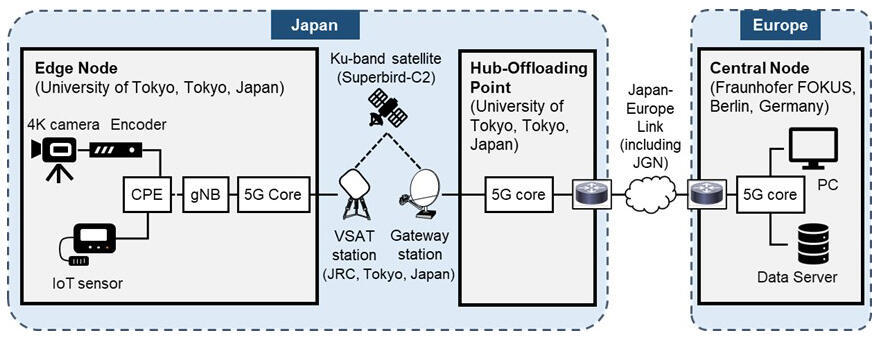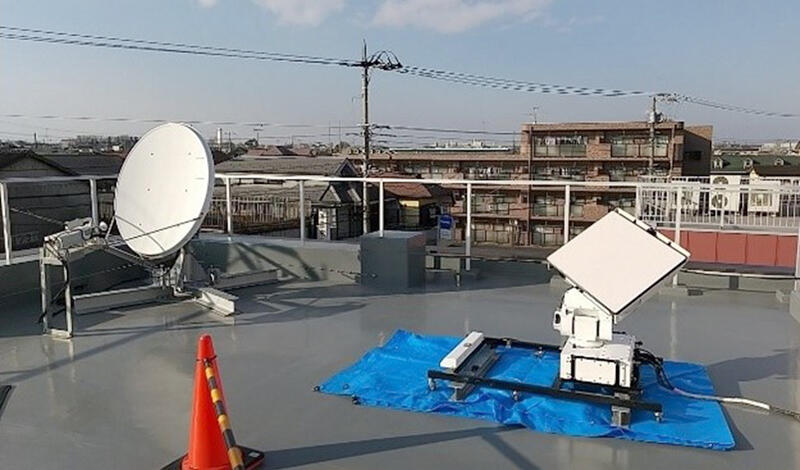For the first time in Japan, a collaborative research project involving four Japanese and European parties has conducted experiments on satellite-integrated 5G control that includes geostationary satellite transmissions. The group included Japan Radio Co., Ltd. (JRC), SKY Perfect JSAT, the University of Tokyo's Graduate School of Engineering's Nakao Research Laboratory, and the National Institute of Information and Communications Technology (NICT). It also received cooperation from the European Space Agency (ESA). On June 8, the group announced they had successfully transmitted 5G control signals, 4K video, and IoT data over an international long-haul 5G network between Japan and Europe. This joint experiment was conducted as part of the "Research and Development of Satellite-Terrestrial Integration Technology in Beyond 5G" project commissioned by NICT.
The parties conducted the experiment from January to February of this year. A 5G edge node and relay node were set up at the University of Tokyo's Hongo Campus on the Japanese side, and the central node was set up on the European side. The Ku-band Superbird-C2 satellite was used for satellite communications, and a satellite earth VSAT station with a gateway station in Kokubunji, Tokyo, established by JRC, was used for ground-to-ground communications.

Courtesy of JRC, SKY Perfect JSAT, the University of Tokyo, NICT
A local 5G system with a 4K camera, IoT sensor, 5G base station, and 5G core was built at the edge node. Using this local 5G system, 4K video and IoT sensor data were collected and transmitted via a terrestrial line to the VSAT station in Kokubunji City. This data was then transmitted up to the Superbird satellite and down to the gateway station, also in Kokubunji City, and sent back via a terrestrial line to the relay node (5G core). From there, it was transmitted to the central node (5G core) on the European side using long-distance international circuits, including JGN, a super-high-speed research and development network testbed operated by NICT. On the European side, the 4K video and IoT sensor data were received by a PC and a data server.
The 4K video and IoT sensor data were successfully received, revealing that communication sessions can be established using 5G control signals exchanged between the Japanese and European sides, even with latency caused by long-distance transmission, including satellite links and international links between Japan and Europe. Furthermore, the experiment confirmed that data acquired by 4K cameras and IoT sensors on the Japanese side could be transmitted to PCs and data servers on the European side.
Each transmission segment's network quality was also measured to evaluate the network performance of the satellite link and 5G connection. The results confirmed that satellite-link integration in 5G networks via international long-distance communications could be used for specific transmission applications.

Courtesy of JRC, SKY Perfect JSAT, the University of Tokyo, NICT

Courtesy of JRC, SKY Perfect JSAT, the University of Tokyo, NICT
The four parties have shown that 5G communications can be established over long-distance lines between Japan and Europe, including satellite links. It is hoped this will enable the quick deployment of 5G networks in the sky, ocean, remote islands, and other traditionally difficult areas.
This article has been translated by JST with permission from The Science News Ltd.(https://sci-news.co.jp/). Unauthorized reproduction of the article and photographs is prohibited.




